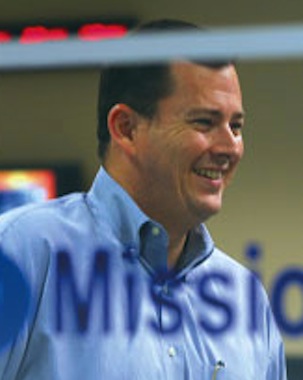by Kristin Todd
In today’s rapidly evolving business world, it is essential for companies to harness technological innovation to better serve society and consumers’ needs. That is exactly Greg Leman’s vision for his Technology Entrepreneurship class. With a class consisting of multidisciplinary students, project teams are assigned a company to collaborate with in order to market new technology, test its feasibility or solve technical problems.
Leman serves as the director of University Entrepreneurial Initiatives and is the Curtis Hankamer Chair in Entrepreneurship. Through his Technology Entrepreneurship class, students become company consultants, integrating technological innovation with problem solving strategies to evaluate and tackle market challenges.
“The mission of this class is to equip a wide spectrum of Baylor graduates with confident skills in the entrepreneurial process,” Leman said. “It involves opportunity recognition and assessment; creating, adapting and deploying diverse resources; and developing leadership that drives value creation.”
Leman said his class, first offered in the spring of 2006, was designed to be the second course in a two-course sequence, with new classes designed as prerequisites. The faces of Leman’s class are engineering and business undergraduates, as well as MBA candidates.
“The mix of students is essential to the concept of the course,” he said. “Commercial success with new technologies almost by definition requires collaboration between technical people and business people. I am deliberately trying to give the students a ‘dose’ of how it will work once they graduate.”
Since the class was new, Leman had to remain aware that students who did not complete the prerequisites might need to be caught up to speed.
“The challenges of a cross-disciplinary group will lessen due to the preparation of more juniors taking the Innovation and Change Management class and engineering and computer science students taking the Global Business and Communication course,” he said.
A difficult concept of technological commercialization is persuading society to acknowledge it has an unmet need. Leman said in many cases, new technology being offered is difficult to market because the idea may only be conceptual.
“Think of iPods,” he said. “Until they existed, along with all the downloading sites, we didn’t know we ‘needed’ them. Yet, the market for them now is enormous.”
Teams of three or four students are assigned projects at the beginning of each semester. The teams meet with company representatives to assess technical opportunities and initialize the commercialization process. The projects are then presented to the client companies at the end of the semester.
“The class trains students in the whole process of commercialization for situations where there exists an ongoing interplay between defining the market and defining the technology,” Leman said.
Leman said he considers several factors when selecting companies for students to work with.
“Most importantly, the company must be doing some kind of commercialization with technology,” he said. “Secondly, the issue has to be a problem that is very important to the company without being the centerpiece of its core strategy. Thirdly, I am looking for situations where we can readily stay connected.”
Leman said the effectiveness of the projects depends on the state of development for both the company’s emerging technology and definable market. A company in need of defining both factors is the best bet.
“If the technical aspects are completely understood, and it is simply a market study for a particular segment, it may be very “high tech” but not what I’m looking for,” he said. “On the other side, if the market need is well-documented, and the sole need is an engineering solution, then there is much less demand for disciplinary interplay.”
Leman encourages maximum interaction with chosen companies to achieve a successful outcome.
“A team meeting at the beginning of the semester and a final report at the end is not enough,” he said. “This means we have to find Central Texas companies, or have good access to collaboration tools online to compensate for distance.”
Shama Blaney, a graduate student, worked on a project for iCyt Visionary Bioscience, Inc. last semester. The company specializes in innovative technology and science solutions. She and her teammates focused on potential markets for iCyt’s emerging technology.
“We looked at alternatives for using the technology in the forms of nanotechnology, pharmaceuticals and rapid prototyping,” she said.
Although the company was not local, students working on the project were given the opportunity to visit the company’s headquarters.
“We got to fly to Illinois to make a company visit,” Blaney said. “It was interesting to see the technology they had there, and see how our research would apply.”
Another team of students worked with PolySpec, a supplier of coatings and linings. PolySpec caters to an international market by providing products for construction and corrosion protection for commercial, industrial, institutional and marine purposes.
Leman said students analyzed opportunity and intellectual property strategies to define a new insulation product produced by PolySpec. He used university connections to establish a partnership with the company through Baylor alumnus, Buddy Ellisor.
“PolySpec owner, Buddy Ellisor, was introduced to me through Dr. Bill Petty and the development office,” he said. “As I learned more about their business and how much they are doing to bring new technologies to market, I realized they would make a great sponsor.”
The projects have proven to be beneficial to both students and participating companies.
“In general, the companies were very pleased with the results, and the students all told me not to take the company project aspect away from the course,” Leman said.
Leman’s vision for a hands-on, pragmatic class seems to be contagious.
“I have gained invaluable knowledge and experience,” said Leah Richter, a senior engineering student. “I now have a greatly increased respect for successful technology entrepreneurs. It has also changed my perspective of the design process as an engineer.”
Leman hopes to produce exceptional leaders through the combination of global and cultural competence; science and technology insight; and business savvy–all built on a Baylor foundation of Christian ethics and integrity. Students also learn to appreciate each others’ strengths while working toward their project goal.
“This course allows you to showcase your business expertise while experiencing the dynamics of cross-functional teamwork in a real-world setting,” said Katie Prichard, a senior entrepreneurship student.
The Technology Entrepreneurship class is still undergoing changes to address issues and establish a more effective class.
“The main obstacle we have seen is that expectations have to be very well managed through the whole process,” he said.
Leman said he is also planning to expand the program overseas next summer to respond to the demands for a balance of global, technical and business competencies.
“The reality of technology commercialization in today’s world is that it is a global process,” he said. “We now have agreements in place at the University of Shanghai for Science and Technology to launch next summer. Shanghai is one of the world’s most vigorous technically entrepreneurial environments, and is one of the cultures our graduates will most likely interact with.”
As for future plans, Leman, who has a Ph.D. in Chemical Engineering, is working with faculty in the Department of Chemistry to make it easier to add chemistry students to his mix of team members. The class structure and curriculum requires constant modifications to accommodate evolving technology and business strategies.
“This is simply a step of ongoing effort to make the course accessible and meaningful to technical students from all specific disciplines over time.”
Baylor Business Review, Fall 2006






